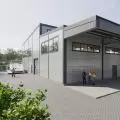In recent years, many cities around the world have seen a growing interest in creating flower meadows. Increasingly, lawns in cities are being replaced by flowers. Colorful and biodiverse spaces not only beautify the urban landscape, but also bring a number of environmental, social and economic benefits.
Anti-smog effect
One of the most important benefits of flower meadows is their ability to improve air quality. In cities, where the problem of air pollution is particularly acute, floral meadows can provide a natural filter that helps reduce smog levels. PM2.5 is particulate matter smaller than 2.5 micrometers in diameter that enters the upper respiratory tract. PM10 is a mixture of organic and inorganic substances with a diameter of less than 10 micrometers. The use of flower meadows helps to keep these particles out. Plants growing in flower meadows better absorb exhaust and tire friction dust[1]. They are up to 10 times taller than grass, so they have a larger surface area and better cleaning efficiency. The efficiency of trapping dust of various types is close to that of trees[2].
Other studies also indicate successes in phytoremediation processes of petroleum-contaminated soils using a mixture of grasses and flower meadows. The term phytoremediation comes from the Greek word phyton - plant and the Latin remediare - to remedy. Soils subjected to a mixture of plant species for a period of 30 months showed a significant reduction in the pollutant load. All thanks to the actions of the naphthophytes - white clover, lanceolate plantain, sickle-leaf alfalfa and a mixture of species that form flower meadows[3].
Canteen in floral meadows
The establishment of floral meadows can stop the displacement of natural meadows from cities. They promote processes that stop anthropogenic processes, and level the effect of urban concrete desert. Thus, they fit in with the EU Biodiversity Strategy 2030. This document emphasizes the need to promote "areas of high value for biodiversity," which includes the management of green spaces[4].
Flower meadows are an invaluable source of food for pollinating insects. In an era of a global pollinator crisis, providing pollinators with adequate habitat is crucial to maintaining biodiversity and ecosystem health. Pollinators are organisms without which humans could not function. They are responsible for the harvest of most of Europe's crops. More than 80% of European crops are directly dependent on insect pollination[5].
Pollinating insects need pollen and flower nectar to live, as well as suitable places to live. Declining pollinator numbers lead to lower yields in orchards and vegetable gardens, which affects the availability of food for humans. Therefore, it is important to preserve meadows and wastelands with flowering plants, and to plant roads and squares with trees and shrubs that are beneficial to these insects. In areas that have been transformed by humans, nectar-rich zones can be created by planting plants that are visually attractive and useful to insects, which is called creating forage belts.
Beneficial tapes are specially composed plantings of plants designed to provide continuous access to food for numerous pollinating insects.
Flower meadows offer shelter for many species of animals. Small mammals, birds, as well as amphibians such as frogs and hedgehogs, find ideal living conditions in them. This is especially important in urban settings, where natural habitats are limited.
At the same time, it should be emphasized that flower meadows attract insects, and therefore also birds. The General Directorate of National Roads and Highways emphasizes that the creation of floral meadows along highways creates an ecological niche that promotes the mass occurrence of pollinating insects, which directly affects the attractiveness of the area for birds and bats. The meadows are also home to ground-nesting birds, including protected species. This can lead to an increase in casualties from collisions with vehicles. It also poses a threat to road users.[6] They should be designed rationally, with an idea of how they will be used in the ecosystem.
Saving Time and Finances
Maintenance of flower meadows is much less demanding than traditional lawns. They require less frequent mowing, fertilizing and watering, which translates into time and money savings. In practice, maintaining an ideal urban lawn means frequent use of mowers, often irrigation systems and chemical pesticides, which generates significant costs, both financial and environmental.
In the case of floral meadows, maintenance costs are significantly lower. First, floral meadows do not require frequent mowing - usually one or two mowings per year, performed after the plants have flowered, in sensitive areas like the edge of the roadway, only trimming the edges is sufficient.
Secondly, these meadows are more resistant to drought and do not need regular irrigation. The height of the plants and their diversity affect the moisture content of the soil. At the same time, thereby combating the urban heat island. Flowery meadows have a complex root system that binds rainwater in the soil, retaining moisture longer than a lawn and positively influencing the groundwater balance, are drought-resistant and practically do not need additional watering, as the plants that make up flower meadows have up to 25 times deeper roots and better water absorption capacity than a lawn, which reduces surface runoff of rainwater and reduces the risk of flooding often observed in sealed areas[7].
Thanks to their species diversity, flower meadows are also less susceptible to disease and pest invasions, eliminating the need for chemical protection measures.
Impact on Living Comfort
Residents of large cities are increasingly looking for traditional solutions, seeking a return to nature. Flower meadows resembling country fields and gardens are just one example. The aesthetic aspect of floral meadows should not be forgotten. They are a visual enrichment of the urban landscape, which changes dynamically with the seasons. Floral meadows have a positive impact on mood - it is well known that colorful flowers and green spaces have a soothing effect. Such initiatives also have social aspects, as they build identification with a place, created in housing estates, parks - they create places for neighbors to meet and cooperate.
From an economic perspective, flower meadows can support urban agriculture, and organic meadows help to support urban beekeeping. In recent years, thanks to participatory budgets, more and more flower gardens are being established.
How to establish a flower meadow? The State Water Company has issued a short guide in 5 steps.
Examples of cities with floral meadows
Bialystok has been implementing a project to create floral meadows in the city since 2019. In 3 years, nearly 15 hectares of floral meadows have been created in this city. The first meadows, with a total area of 5.5 hectares, were created in 2019. They were created in road lanes, community plots and at landmarks in the city[8]. Large cities are known to have been actively creating floral meadows in various parts of the city for several years. Flower meadows in Krakow were established in 2017 in 20 locations in different parts of the city, More than 20 hectares of lawns have been converted into flower meadows here in a few years. Szczecin and Gdansk have also been at the meadow forefront for several years.
Medium-sized cities have also joined the initiative and started to introduce floral meadows in their areas. Examples include Swidnik and Radom. Leczna, Rawicz, Łuków, Hel, Ustronie Morskie, Żarów: in turn, these are small cities that have also decided to do so, showing that flower meadows are valuable urban infrastructure, a space worth having regardless of the size of the city.
The residents of our cities need floral meadows more than they currently think[9]. Floral meadows in cities are not only beautiful and aesthetically pleasing, but most importantly an investment in the health and quality of life of residents and environmental protection. Their role in urban space is invaluable and will certainly grow with the increasing environmental awareness of the public.
Magdalena Milert
[1] Robert Horbaczewski. Flower meadows along public roads. Law.co.uk. Accessed 16.05 2024, from: https://www.prawo.pl/samorzad/laki-kwietne-przy-drogach-publicznych,511620.html
[2] Smogówka | Meadow Foundation. Laka.org.pl; Accessed on 16.05 2024, from: https://laka.org.pl/co-robimy/laka-antysmogowa/
[3] Składowska, M. Phytoremediation of petroleum-contaminated soils using a mixture of grasses and flower meadows. Natural environment as a research area, 71.
[4] Jermakowicz, E., Jablonska, U., Burzynska, J., Wrobel, K., Charubin, B., Kozikowski, D., ... & Kostro-Ambroziak, A. (2022). Eden city: the structure" of flower meadows" and their potential in supporting bee diversity.
[5] Woś, B. Protecting biodiversity. Pollinator-friendly gardens.
[6] Horbaczewski, R. (2021). Flower meadows needed by the roadside, regulations too. Law.co.uk. Accessed 16.05 2024, from: https://www.prawo.pl/samorzad/laki-kwietne-przy-drogach-publicznych,511620.html
[7] Flower meadows for the drought period - State Water Management - Gov.pl Portal; State Water Management. Accessed 16.05 2024, from: https://www.gov.pl/web/wody-polskie/kwietne-laki
[8] Szatylowicz, E., Skoczko, I., & Krawczyk, D. A. INNOVATIONS SUSTAINABILITY MODERNITY OPENNESS.
[9] Flower meadows and the Polish case. UrbanLab. Accessed 16.05 2024, from: https://urbanlab.gdynia.pl/artykuly/laki-kwietne-a-sprawa-polska/














